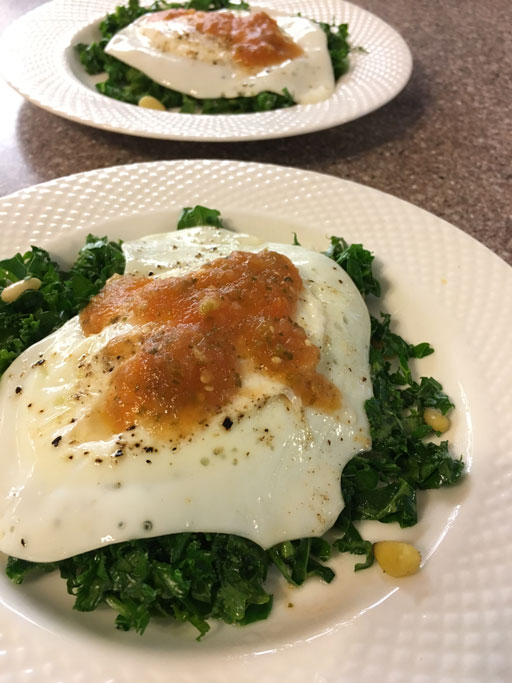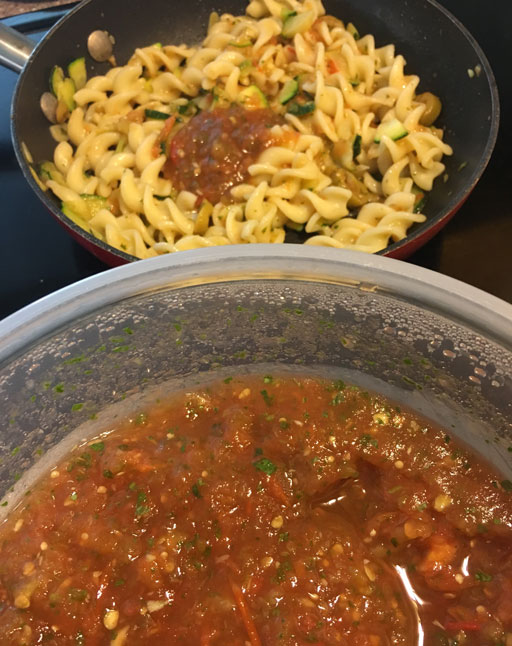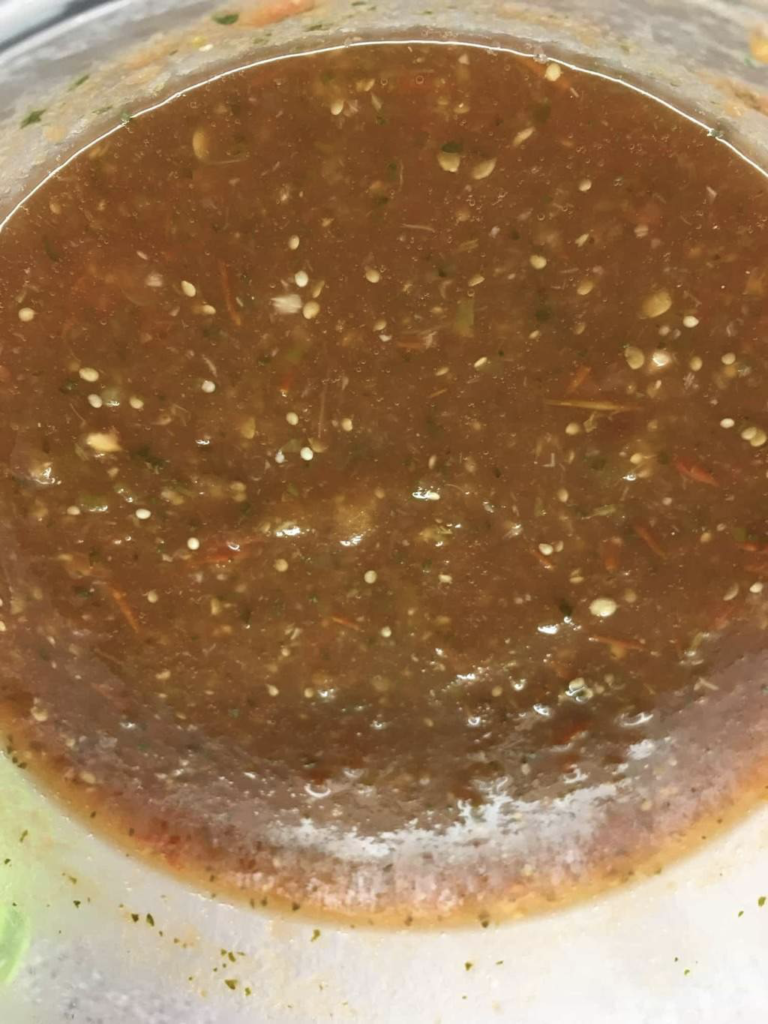
How to Create Your Signature Salsa Recipe
Do you prepare your own, or do you purchase ready-to-eat salsas?
I have one favorite salsa recipe. It is my favorite, not because it is the best salsa. It is my favorite because it easy to use as the base to create other more complex, tasty salsas.
I will share this favorite recipe first, and then I will help you map out the process for creating your signature Mexican salsa recipes.
This recipe is a bit loose. By that, I mean that the quantities don’t need to be exact. Your salsa will be more delicious if you adjust the amount of the ingredients according to your liking. For example, if you love garlic or cilantro, feel free to add more of it, or if you want your salsa to be extra hot, use extra peppers, etc. This recipe will make about 4 cups. It can refrigerate for 2-3 days.
My favorite way of eating salsa is as a snack with corn chips or on tacos and tostadas.
We prepare salsa once or twice a week.
Mostly we use it in place of stock to prepare a variety of guisados or stews. You can incorporate the same salsa into many recipes and not feel like you are repeating a meal.

My Favorite Mexican Salsa
Ingredients: (Mild to Medium Heat)
- 5 small red tomatoes
- 5 green tomatillos
- 1 serrano pepper
- 1 jalapeno pepper
- 2-3 cloves of garlic
- 1 /3 bunch cilantro
- salt & pepper to taste
Prepare Ingredients:
This preparation section is a bit long because I wrote down small steps separately, and I added a few tips about how you might adjust it, but the process is not that complicated.
- Remove the outer leaves from the green tomatillos
- Peel the garlic
- Cut off the larger cilantro stems
- Wash all of the vegetable
Cooked Salsa Ingredients
- Place the garlic, peppers, and tomatillos in a 3 to 5-quart saucepan and fill with water until vegetables are covered.
- Place on the stovetop and bring to a boil under high heat. Reduce heat and simmer on low-med heat until the tomatillos are soft, 10-15 minutes.
- Remove tomatillos into a bowl with a slotted spoon.
- Leave the peppers and garlic in the pot, turn the heat off and leave it on the stove.
- Add the red tomatoes to the hot water and let them sit in it for 5-7 minutes.
- Some people remove the tomato skins before processing. I leave the skins on.
- Drain water and leave the peppers, garlic, and red tomatoes in the saucepan until needed.
- Decide if you want the salsa to be smooth or extra chunky.
Process Salsa Ingredients
- Place the tomatillos in the food processor 2 or 3 at a time, depending on the size. Tomatillos have a lot of liquid, so use the pulse setting to break the skins slowly. Use a blender if you do not have a food processor, or if you want to create an authentic experience, you can use a mortar and pestle. Process them to desired consistency
- Pour the processed tomatillos into a sealable 4-6 cup capacity container.
- Use a slotted spoon to place red tomatoes in the food processor. Process just like the tomatillos, 2 or 3 at a time. Pour into the bowl each time over the tomatillos. Process them to desired consistency
- Place the garlic and cilantro in the food processor. Pour into the salsa container.
- Add the peppers to the food processor (with or without seeds). Process them to desired consistency
- If you want a spicier salsa, leave the seeds, and mince the peppers. The bigger the chunks, the spicier the salsa. If you want something very spicy, then you add more peppers to the recipe.
- If you want your salsa to be mild, remove the seeds, and add a couple of spoonsful of the processed tomatoes. Then add a little bit of this mixture to the rest of the salsa. Mix well, taste, and adjust as needed. Discard any remainder pureed pepper or freeze if you want to use it in your next salsa.
- Once all of the ingredients are processed, use a large spoon to mix the ingredients well.
- Add salt and pepper to taste and mix again.
Storing Salsa
- Allow the salsa to cool off before sealing and placing it in the refrigerator.
- Sometimes it makes sense to bring the salsas up to room temperature. You may even want to heat them when you serve them with warm or hot foods.
- Tomato is the ingredient that diminishes the shelf life of this salsa in the refrigerator. After 4 or 5 days, you can detect the deterioration of the tomato flavor in the salsa.
- You may be able to lengthen the shelf life by a couple of days if you cook the salsa in oil.
- You can extend it much more if you freeze it.

Create Your Signature Mexican Salsa
It is not necessary to start with a base to create unique salsa recipes. I find it simpler to use something I already know as the starting point.
As you will see below, creating your signature salsa recipes is just a matter of considering a few variables and choosing preferred methods to execute your salsa recipes. You then refine the recipes until you are satisfied with what will become your signature creation(s).
I have to recreate my salsa recipe worksheet because I can’t find my original. Email me if you are interested in a copy once I have it.
A few variables to consider when creating unique Mexican salsas are as follows:
1. Traditional Mexican Salsa Ingredients
- Peppers – In addition to many other ingredients, you can prepare mild or spicy salsas with one or several types of peppers. You can Select fresh peppers or a combination of fresh, canned, or dried peppers.
- Canned peppers, such as pickled jalapenos, or chipotles are also good choices. You can use rehydrated dried peppers. Powdered or pepper flakes are also good options. Bottled salsas can add depth to your salsa. Many non-spicy peppers provide great depth of flavor as well. Ask grocery store produce managers any questions you may have. They may be able to give you specifics about peppers with which you are not familiar.
- Tomatoes, green tomatoes, tomatillos
- Shallots, onions, scallions, green onions, garlic (fresh or powder)
- Cilantro, parsley
- Lemon, limes
- Olive Oil
- Salt, sea salt, celery salt
- Ground/whole peppercorns
- Ground/whole cumin
- fresh/powdered/pickled garlic
- ground/whole oregano
Additional Notes About Ingredients:
The above ingredients are the most traditional, but with the popularity of fusion cuisines, the sky is the limit as far as ingredients for a great salsa are concerned. In addition to peppers and other vegetables, you can use fruits, herbs, and spices. With practice, you can create new salsa recipes. Use these improvised new recipes to re-invent ordinary dishes or to create new ones.
2. Cooking Methods
Cooking Methods may vary. You select a combination of methods depending on your preference for specific ingredients.
- No Cooking – Process all fresh ingredients – the refrigerated shelf life is minimized
- Boiling – As described above
- Stovetop – Brown whole ingredients in a pan using a small amount of oil and low heat
- Burner – Use a long fork and cook ingredients over direct flame
- Oven/roast– Roast on lightly oiled cookie sheets
- Oven/Broil – The oven broiler concentrates the heat on the top element. You place the cookie sheet with the vegetables on the highest oven shelf. It results in slightly charred skins that add a unique smoky flavor to your salsas, similar to when cooked on an open flame. Cook vegetables for 2 – 5 minutes on each side.
- Sauté – Sauté freshly chopped ingredients in olive oil before processing
Additional Notes About Cooking Methods
**Make sure that you cook peppers and onions in a well-ventilated area as the fumes can become irritating to the eyes and throat.
**Avoid burning vegetables as this may produce harmful chemicals
3. Kitchen Tools and Equipment
Kitchen Tools and Equipment used may vary. Find here a partial list of utensils you may need.
- Oven/Broiler
- Stove Top
- Sauté Pan
- Grill pan
- 3-5-quart saucepan
- Slotted spoon
- Knife
- Food processor or blender
- 4-6 cup capacity bowl with lid
- Spice grinder
- Mortar and pestle or the real thing, a molcajete
Canning Salsas is not a Simple Process.
If you are interested in canning your salsa, do some research first. There is some science to take into account to meet FDA standards and to prevent food poisoning.
Some canning salsa recipes that have been laboratory tested appear on the following link from a university system in Washington State Salsa Canning Recipes.
By providing a lot of information on this post, the intent is not to scare you away from being creative in the kitchen. It would be the total opposite. You cannot go wrong if you start by using ingredients that you already know and like. Have fun in the process of inventing your signature Mexican salsa recipes.